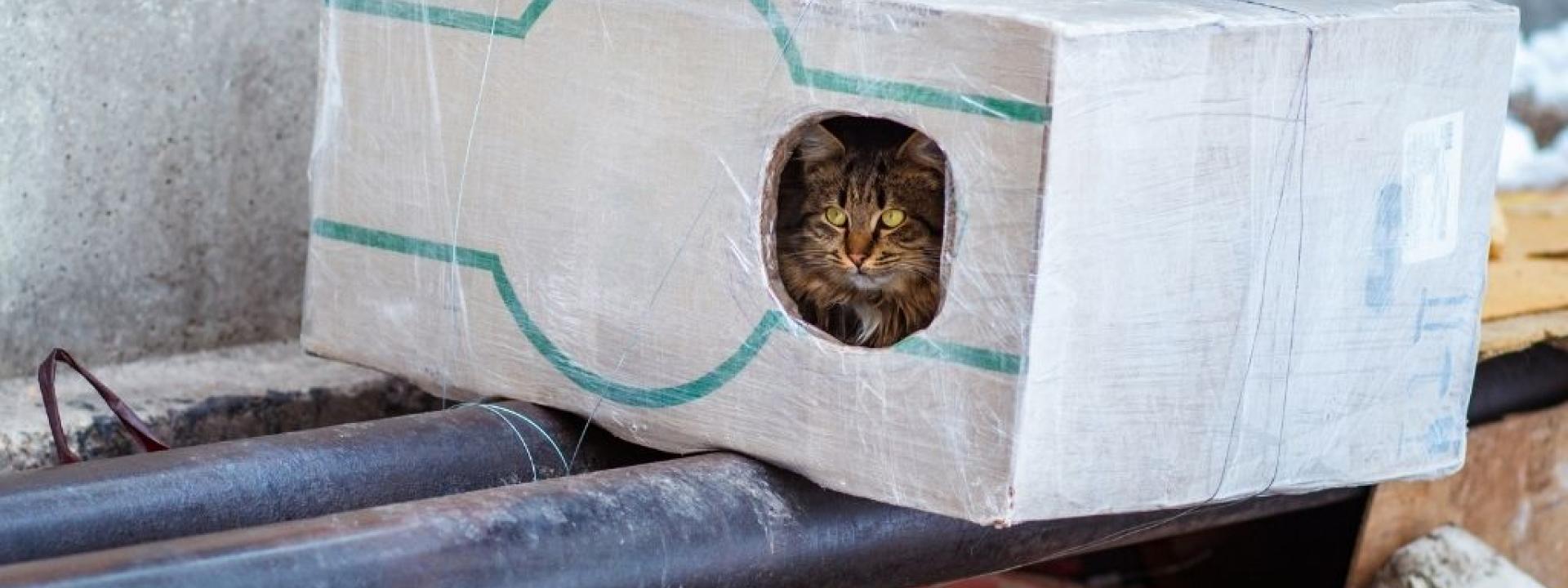You may have some cats in your neighborhood that have adopted you, or if you really understand the nature of these kitties, you know that they go where they get their food. Some of these cats have been lost, abandoned, or they may even be from a cat colony. Whether you call them alley cats or feral cats, these animals have likely found a way to your (admittedly bleeding) heart, despite their hissing and standoffish nature. As veterinarians, we can completely appreciate that, and we know you want to help them stay safe during the winter months.
First, you will want to know if the cat(s) that come to visit you have a home. You can try and find out by asking neighbors if they know where the cat(s) are from and any history that they might know. You can also ask the local animal shelter if they have someone that can come and scan the cat or if you would need to bring them to the shelter. They may even have resources to help if the cat needs to be spayed/neutered or receive vaccinations.
If the cat doesn’t have a home and you want to provide a safe space for them this winter, they will need the basics—food and shelter.

What You Need to Understand About Feral Cats Vs. Neighborhood Cats
A neighborhood or feral cat can be fearful of humans but is still somewhat domesticated. Always be cautious with these cats—go slow, and eventually, they may come to want affection. Because some neighborhood cats may have had a home, they might have had someone caring for them and providing for their needs. These cats will likely need more help with getting through the winter than some feral cats that have had to fend for themselves.
Feral cats are ones that are not domesticated and are extremely fearful of people. They will run if approached, hiss, or even scratch/bite if they feel threatened. The chances of these cats warming up to a person and seeking their affection are meager, and it could take years for them to be touched.
Food For Feral Cats
If you leave food out all the time, you will likely attract other animals to your home. Put the food out when the cat is around and then remove it when they leave. If you are busy and can’t always catch them when the cat is near, you can leave it out during the day and take it away at night; that is when other wildlife likes to forage. Because wildlife can pass on diseases like rabies and internal and external parasites and can cause injury to your neighborhood cat, the best thing is not to make food accessible when these generally nocturnal animals are around. Don’t forget to leave water out for them as well as long as it won’t freeze.

Shelter For Feral Cats
The cat will look for shelter in a place where they feel that they are safe. There are a few tutorials on how to make an outdoor shelter for cats by using a basic cooler, or plastic tote, by cutting a door in the side and lining it with styrofoam or old blankets. Place it in a low traffic location, away from people and other pets that may want to bother them. Keep the door facing away from any cold winds. You can place the shelter where you have noticed them resting by a bush or under a deck.
Putting their food inside the shelter will entice them to go in, but you can do this gradually if the cat is skittish. Place the food by the door and slowly move it inside and towards the back. Remember not to leave the food out at night to prevent other animals from taking over the shelter.
If you notice that the cat isn’t taking to the shelter, keep adding additional shelters around, and if they get cold enough, they will seek out shelter. Vary the shelter type, have one without styrofoam and just blankets or use straw or wood shavings. Adjust the size of the openings, and add branches around the outside of the box. It may take them a few days to get comfortable with these, so start placing them out before it starts to get really cold.
Relocating Feral Cats
If you can’t get the cat to use the shelter and it is looking like it may be a risk from the elements, you may want to think about relocating. Relocation requires you to trap the cat and work with an organization or shelter that could take the cat for a short period. The time they spend at the shelter is a great time to get them spayed or neutered if they have had the procedure yet.
If relocating them is not an option, you can try to keep them in a garage or a spare bedroom. They will want to get out, and you should be aware that some feral cats will harm themselves if they are trying to escape. If they do try and escape and risk injury, it may be best for their mental state to let them stay outside and continue to try and use the shelters.

Feral Cats and Affection (Or Lack Thereof!)
You've likely heard of stories of families "taming" feral cats and bringing them indoors to become part of their brood. And while this does happen, it's really more the exception than the rule. Feral cats generally do not like to be touched or picked up. Let them come to you. With feral cats, it takes time to build their trust. You may not get to pet them, but know that you help provide for them and better their survival chances.
Resources For Feral Cats
You might be interested in learning more about helping feral cats, neighborhood cats, or maybe cats in general.
Some great resources for feral cats and even domesticated cats are as follows:
- https://www.alleycat.org/
- https://www.avma.org/resources-tools/avma-policies/free-roaming-abandoned-and-feral-cats
- https://catvets.com/
- https://catfriendly.com/
If you have any questions about how to help feral cats, or you perhaps want to find out if a neighborhood cat that keeps showing up is microchipped, please don’t hesitate to give us a call!

